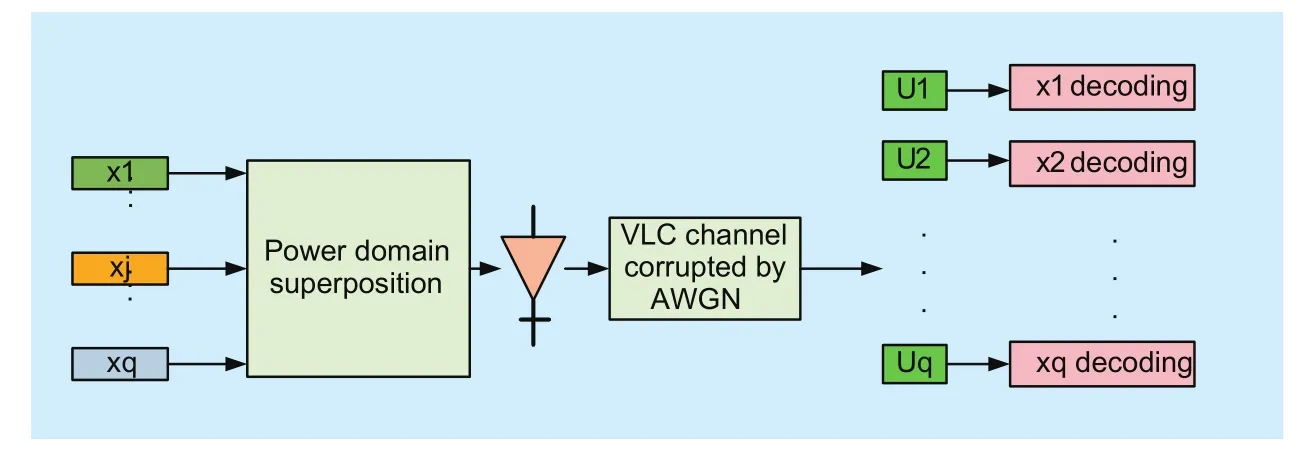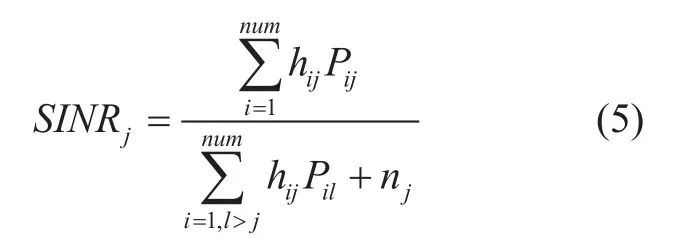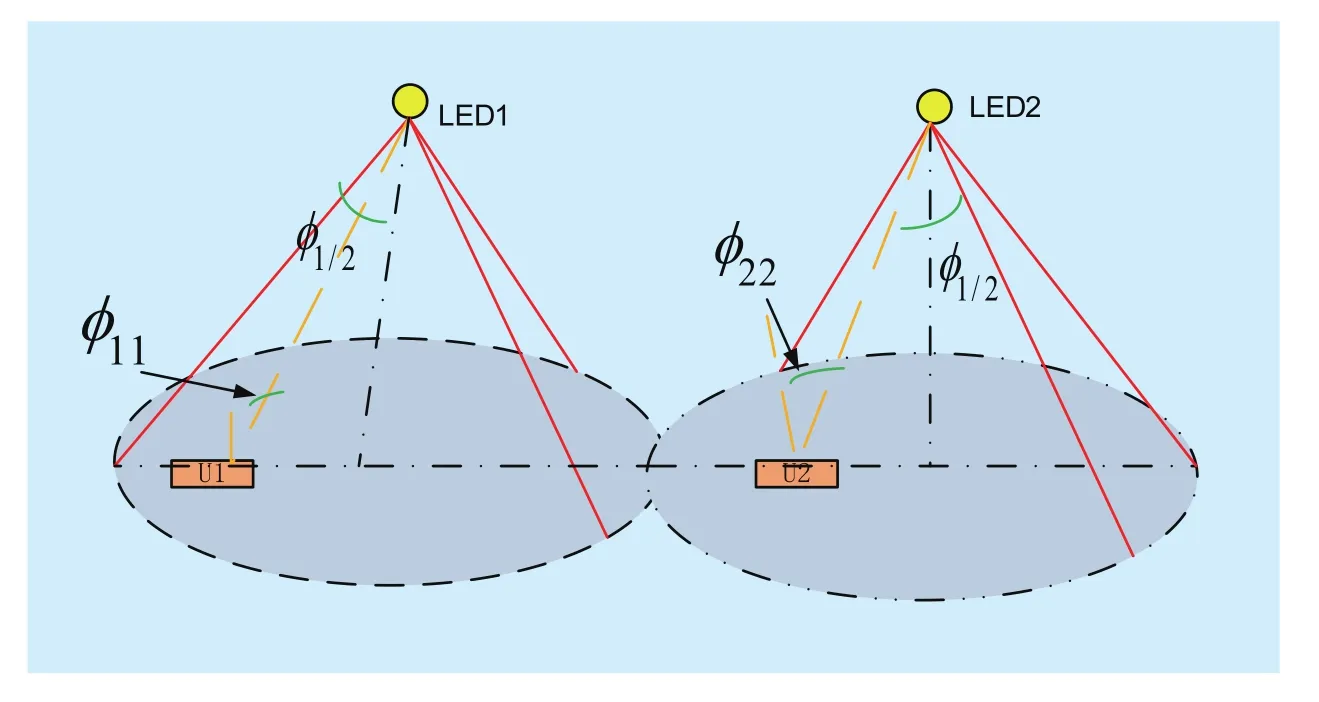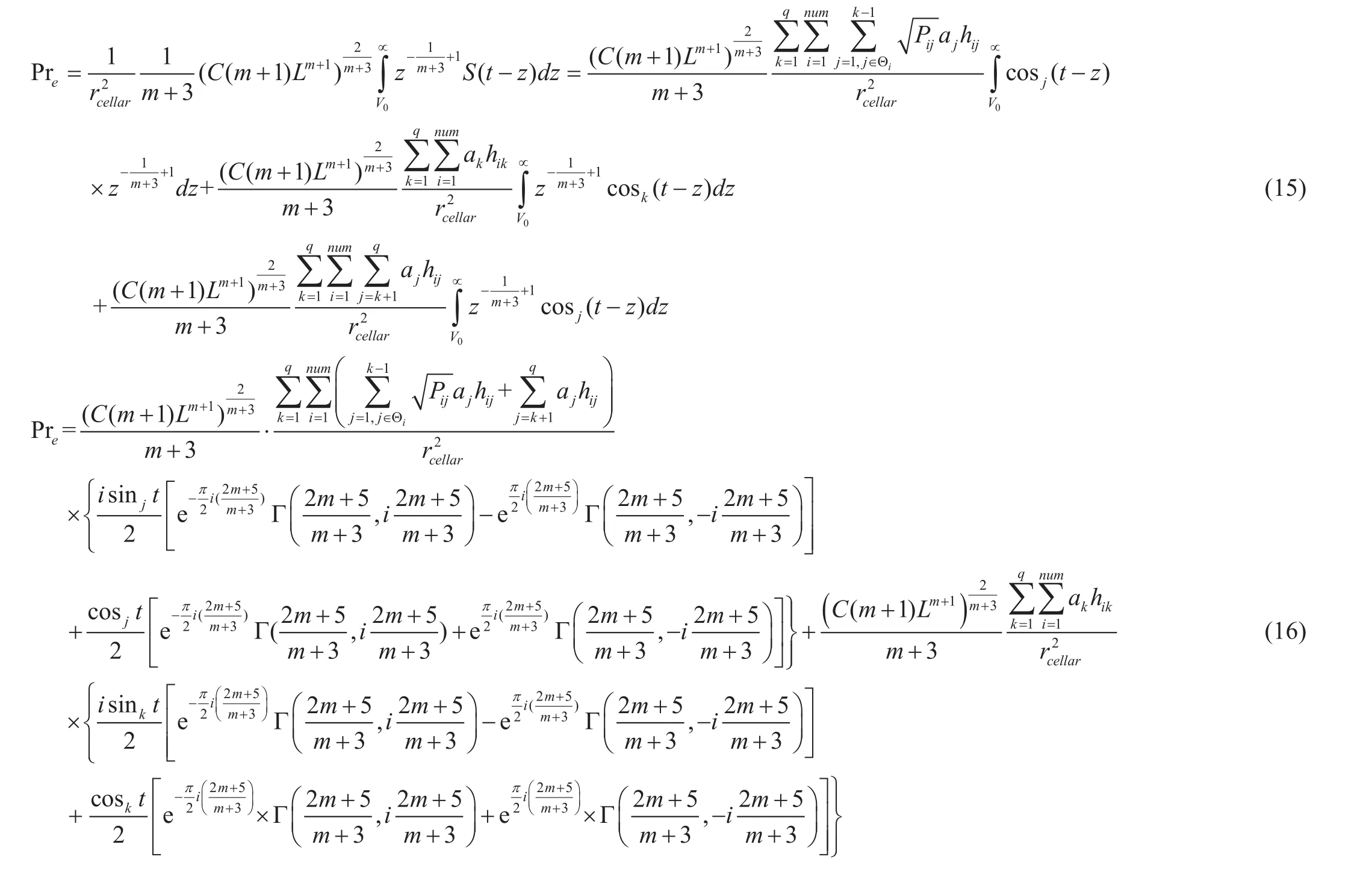Symbol Error Rate Performance Analysis of Non-Orthogonal Multiple Access for Visible Light Communications
College of Telecommunication and Information Engineering, Nanjing University of Posts and Telecommunications, Nanjing, China
I. INTRODUCTION
The visible light communications (VLC) is considered as one of the most promising technologies for the next generation wireless communications systems, which has the advantages over radio frequency based systems such as operation in unregulated wide spectrum and energy efficiency [1]. Currently, with the increasing implementation of light emitting diodes (LEDs), the VLC grows rapidly for the purpose of data transmission and environmental detection [2]. A variety of wireless access schemes have been proposed for improving the performance of VLC, such as orthogonal frequency division multiple access (OFDMA)and non-orthogonal multiple access (NOMA)[3]-[6].
In recent years, the anticipated 1000-fold explosive data traffic growth by 2020 causes great challenges on the design of fifth generation communication systems (5G), which indicates that data rate enhancement aspect and error propagation control technique have been regarded as a key issue in the next-generation communication system [7]. Some fundamental work was well investigated such as massive multiple-input multiple-output(MIMO), NOMA, and millimeter wave communication, which is regarded as an important trend of 5G [8]-[12]. NOMA is considered as one of promising techniques for the next generation wireless communication [13], which allows more than one user to be multiplexed on the same sub-channel so as to improve spectrum efficiency. Also, NOMA allows all users to share each resource element, and the users’ power is allocated through iterative water-filling [14]. Many scholars propose different schemes to eliminate interference in the communication systems[15]-[16], and one essential characteristics of NOMA is that it can remove inter-users or inter-cellular interference. On the basic of the principle of NOMA[17], users with poorer channel conditions are allocated more signal power to decode their own messages, while users with better channel conditions are allocated less power but employ successive interference cancellation (SIC) to decode and remove the messages which are intended for the other users with poorer channel conditions. Furthermore, it is noted that orthogonal frequency division multiple access(OFDMA) is an effective multiple access scheme but it cannot be deployed directly to VLC systems due to the restriction for positive and real signals imposed by IM and the illumination requirements [18]. Additionally,adapting OFDMA in order to cope with VLC requirements causes sharp reduction of spectral efficiency, which is a crucial weakness in emerging communications that typically require significantly increased throughputs[19]. Thus, VLC-OFDMA systems require tremendous complexity and its performance may be degraded by the poor spectral efficiency, and it is of great significance to take the advantages of the NOMA to optimize the VLC-NOMA networks. VLC-NOMA model is first proposed [20] in order to achieve advanced high-rate VLC networks. The quality of service based NOMA is presented in [21],which investigates the outage probability and the illumination quality, etc. In [22], the authors explore a user-grouping scenario based on user locations for VLC-NOMA multicell networks. [23] presents a downlink VLC system using NOMA in order to obtain higher spectral efficiency. However, to the best of our knowledge, as a vital principle of a communication system, the symbol error rate (SER)performance has not been investigated in VLC-NOMA theoretically. Specifically, SER is a key index to evaluate the reliability of wireless communication systems.
In order to provide theoretical support for designing VLC-NOMA,we derive its analytic expressions for the symbol error rate(SER).

Fig. 1 Framework of a VLC-NOMA network
In this paper, our work is summarized as below. i) According to the realistic VLC system and the principles of NOMA, a VLC-NOMA model with multiple users is developed. ii)Based on the VLC-NOMA framework, mathematical expression for SER analysis is provided. To be specific, convolution theory and subsection integral method are introduced to simply this problem. iii) With the aids of computer simulation, it is confirmed that our proposed VLC-NOMA scheme outperforms than the OFDMA scheme in terms of its SER performance. Also, the number of users, semi-angle and power allocation coefficient is considered in our numerical analysis for access the performance of the VLC-NOMA scheme.
The rest of this paper is organized as follows. In Section 2, we establish a VLC system model. In Section 3, we develop a VLC-NOMA framework and present its mathematical expression of the SER. Representative simulations are conducted to verify the SER expression of VLC-NOMA in Section 4. Finally we conclude this work in Section 5.
II. SYSTEM MODEL
Consider a VLC system, which consists of LEDs and users, and its framework is shown in figure . 1. Specifically, for simplifying this realistic scenario reasonably, we take a primary VLC network into account. This network includes a LED that is located on the ceiling, and corresponding signal transmitter and several users (U). Particularly, the users can be regarded as signal receivers, and LED communicates with the users over the licensed spectrum via the wireless channel. Furthermore, though not only line of sight (LOS)link is included in the VLC system but also the diffuse components caused by light reflections from interior surfaces, previous research has indicated that in a typical environment the strongest diffuse component is at least 7 dB (electrical) lower than the weakest LOS component [24]. Thus, only the LOS link is considered in our paper. As is shown in figure. 2, there are users distributed uniformly in a simple VLC framework, which the LED communicates with users, namely . Without loss of generality, we denote that represents -th LED,and is denoted as the signal vector of the -th user. Also, is assumed as the power from the-th LED to the -th user, while represents the signal transmitted from -th LED. Then, we obtain

Here, presents the number of users, while num is the amount of the LED in the VLC network. Meanwhile, is the index set of users connected to the -th LED, which represents that -th LED communicates with these users.

where is the LOS link gain from the -th LED to the -th user.Obviously, in the VLC network,a lot of complicated components have different impacts on the . With the aids of [25], can be expressed as

where is the detection area of the -th user photodiode (PD), denotes the responsivity of the PD. Also, is defined as the gain of the optical filter used at the -th user. Meanwhile, is the order of Lambertian emission, which is denoted as . Moreover, is denoted as the semi-angle of the LED. represents the gain of the optical concentrator, which can be written as [25]

Here, in the case of , and is the refractive index.
The signal-to-interference-plus-noise ratio(SINR) is an important index to evaluate the performance of a communication system. With the aids of the idea from the Shannon’s capacity formula [26], the SINR is given by

Here, noting that represents the decoding order, and is higher than in the decoding order.In Eq. (5), the multi-user interference can be eliminated by means of SIC, and the process of decoding is performed in the order of increasing channel gain. By contrast, the interference from users of higher decoding order is not avoidable, while it has been eliminated in the order of increasing channel gain. In other words, only the interference from users of lower order can be removed successfully. This also implies that the power allocation schemes of the users are very critical for the good performance of the VLC networks.

Fig. 2 VLC-NOMA system model
III. SER ANALYSIS FOR VLC-NOMA NETWORKS
In this section, we present the SER analysis based on the VLC-NOMA framework. Since a big advantage of the NOMA is that it can realize the best power allocation scheme according to signal strength, it can achieve better SER performance and it is more reliable than conventional OFDMA schemes. At first, a VLC-NOMA framework is established.Then, numerical analysis of SER based on the VLC-NOMA network is presented.
3.1 Problem formulation
In the NOMA framework, the unipolar message signals for different users are superposed in the power domain over the LED-users channel. After going through the optical channel corrupted by the AWGN, SIC is carried out at the users to eliminate co-channel interference.Hence, combining with the Eq. (1), the superposed signal to be transmitted at the LED can be obtained as

where ajis denoted as the power allocation coefficient for the -th user. Specifically, it is normalized as

In Eq. (7), is varied for different channel qualities. In detail, is larger in the case of poorer channel qualities. Without loss of generality, we assume that . Then, using Eq. (2),we obtain

3.2 SER analysis for VLC-NOMA
Based on the VLC-NOMA framework we established above, in order to evaluate the reliability of this framework, the SER analysis is provided in this section. Due to the random distribution of the input of the VLC network,all the samples and variables fail to be corresponding to typical probability distribution.Meanwhile, since the diversity and randomness of the signals, it is not appropriate to assume the probability distribution based on empirical results. Hence, in order to illustrate the probability distribution of the signals in a proper way, we are supposed to introduce the probability density function (PDF) of the unordered variable [21] that derived from the method of “change of variable”, which can be obtained as

where represents the communication radius of the VLC network, and is defined as the distance from the LED to the users. Moreover, x∈[kmin,kmax] is defined as variable of the PDF, where kminand kmaxare denoted asand, respectively. In addition, for the purpose of expressing readability, we denote that. Similarly, the cumulative distribution function (CDF) can be given as

Then, since the signals we transmitted through the VLC networks is unipolar signals,the SER is obtained as

Noting that the threshold is , using the “0-1”criterion, we denote

Assuming that , Eq. (11) can be rewritten as

However, it is very complicated to solve Eq. (13) directly. Fortunately, [27] provides us an effective way to simplify this problem, and thus the SER can be given by

Next, we denote as the Gamma function,and the waveform is the most common Cosine wave. In other words, . Using the integration method, the expression of the SER can be given as (16) shown in the bottom at this page.
Here, it is noted that the signal transmitted via the VLC networks is the unipolar signals.And thus, without loss of generality, is assumed. From Eq. (16), we observe that many factors have impacts on the SER performance of the VLC-NOMA networks, and we are bound to evaluate its performance in different cases.

IV. NUMERICAL SIMULATION AND DISCUSSIONS
In this section, we discuss a numerical analysis of our proposed VLC-NOMA scheme. MATLAB is employed to run the proposed analytic expression. To be specific, after comparing the SER performance of the VLC-NOMA scheme with that of conventional VLC-OFDMA,we investigate the relationships between the SER and the power allocation coefficient, the number of users, as well as the semi-angle. In this simulation, is set as 3m, and is defined as 3.2m. Also, all the LEDs and PDs are assumed that have the same characteristics, which the is 0.26W.

Fig. 3 SER comparisons between OFDMA and NOMA

Fig. 4 The SER of NOMA for different
Figure 3 shows the simulation results of the SER performance in the case of OFDMA and NOMA schemes. It can be seen from figure 3 that the SER is decreasing with the increasing of SNR. Also, we observe that the SER of the VLC-NOMA is less than that of OFDMA scheme. Specifically, this characteristic is more apparent when the SNR is large. The SER is close unlimitedly to 0 when the SNR is 8 dB for the NOMA scheme. . This result is dedicated by the power allocation scheme based on the NOMA is more equipment. Also,the SIC which is a typical characteristic of NOMA can further minimize the error propagation. And we can conclude that NOMA is a more appropriate scheme for VLC system to achieve more reliable performance.
In figure 4, we depict the SER with different power allocation coefficients, where are considered. Initially, the amount of users is set as 2 and the semi-angle is denoted as .Obviously, we can see that best SER performance can be realized at , which has nearly no error as long as the SNR is larger than 4 dB.It should be pointed out that the SER performance is sensitivity to the power allocation coefficients, which the SER is significantly reducing although is changed from 0.1 to 0.3.
Figure 5 illustrates the numerical results for different number of users, which are set as 2, 4 and 6, respectively. It is observed that as the number of users increases, the SER performance of the VLC-NOMA scheme is deteriorated. To be specific, the SER is reduced to 10−4approximately when two users are set in the framework and the SNR is 4dB. This result is obtained at the cost of efficiency, since more users in the network can increase the efficiency of this communication system but the effi-ciency and the reliability fail to be enhanced simultaneously. It is of great significance for us to balance the efficiency and the reliability.Additionally, as shown in figure 5 the SER is also can be ignored when the number of users is 4 though the two-users one is slightly better in the case of SNR is 4 dB. In other words,the number of users is double but the SER performance is still beyond our expectation,which implies the 4-users scheme can realize the ideal efficiency-reliability trade-off and the performance of the total VLC-NOMA system is better.
In figure 6, the SER performance in the case of varied semi-angles is investigated.Observe from figure 6 that the case of the semi-angle is performs better than the other cases in terms of its SER performance when the number of users is 2. It is also seen from figure 6 that as the semi-angle increases from to , the SER performance improve accordingly when the number of users is 4. This is due to the fact that the semi-angle has impact on the power allocation and the power concertation.In our experiments, we further observe that the optimum choice of LED with semi-angle varies for different number of users, which indicating that selecting different LEDs would obtain varied SER performance.
V. CONCLUSIONS
In this paper, we present the SER analysis of the novel VLC-NOMA framework. After establishing the VLC network with multiple users, the NOMA is employed to optimize the modulation mode of the VLC network.For this VLC-NOMA scheme, we obtain the mathematical representation of the SER,which is closely related to the efficiency of the VLC-NOMA network. Simulation results also demonstrate that the VLC-NOMA scheme can achieve better performance than the OFDMA scheme. Furthermore, numerical results of SER performance contribute us a reasonable method to select the coefficients of the VLC-NOMA system for realizing better SER performance. In addition, we can employ the full-duplex communication into the proposed scheme to improve the performance.
ACKNOWLEDGEMENT
This work was supported by National Natural Science Foundation of China grants (No.61401069, No. 61271240, No. 61501254),Jiangsu Specially Appointed Professor Grant(RK002STP16001), Innovation and Entrepreneurship of Jiangsu High-level Talent Grant(CZ0010617002), High-level talent startup grant of Nanjing University of Posts and Telecommunications (XK0010915026) and “1311 Talent Plan” of Nanjing University of Posts and Telecommunications.

Fig. 5 The SER of NOMA for different number of users

Fig. 6 The SER of NOMA for different semi-angles with changing number of users
[1] S. Wu, H. Wang and C. H. Youn, “Visible light communications for 5G wireless networking systems: From fixed to mobile communications,” IEEE Network, vol. 28, no. 6, pp. 41-45,Nov.-Dec. 2014.
[2] C. G. Gavrincea, J. Baranda and P. Henarejos,“Rapid prototyping of standard-compliant visible light communications system,” IEEE Communications Magazine, vol. 52, no. 7, pp. 80-87,July 2014.
[3] Y. Zhang, H. M. Wang, T. X. Zheng and Q.Yang, “Energy-efficient transmission design in non-orthogonal multiple access,” IEEE Transactions on Vehicular Technology, vol. 66, no. 3, pp.2852-2857, Mar. 2017.
[4] Z. Ding, L. Dai, R. Schober and H. Vincent Poor,“NOMA meets finite resolution analog beamforming in massive MIMO and millimeter-wave networks,” IEEE Communications Letters, vol. 21,no. 8, pp. 1879-1882, Aug. 2017.
[5] X. Bao, X. Zhu, T. Song and Y. Ou, “Protocol design and capacity analysis in hybrid network of visible light communication and OFDMA systems,” IEEE Transactions on Vehicular Technology, vol. 63, no. 4, pp. 1770-1778, May 2014.
[6] Z. Ding, L. Dai and H. V. Poor, “MIMO-NOMA design for small packet transmission in the internet of things,” IEEE Access, vol. 4, no. , pp.1393-1405, 2016.
[7] Chih-Lin I, Corbett Rowell, Shuangfeng Han, et al., “Towards green & soft: A 5G perspective”,IEEE Communications Magazine, vol. 52, no.2,pp. 66–73, Feb. 2014.
[8] J. Zhang, L. Dai, Z. He, S. Jin and X. Li, “Performance analysis of mixed-ADC massive MIMO systems over Rician fading channels”, IEEE Journal on Selected Areas in Communications, vol.35, no. 6, pp. 1327-1338, June 2017.
[9] J. Zhang, C. Pan, F. Pei, G. Liu, X. Cheng,“Three-dimensional fading channel models: A survey of elevation angle research”, IEEE Communications Magazine, vol. 52, no. 6, pp. 218-226, Jun. 2014.
[10] J. Yuan, M. Matthaiou, S. Jin and F. Gao, “Tightness of Jensen’s bounds and applications to MIMO communications”, IEEE Transactions on Communications, vol. 65, no. 2, pp. 579-593,Feb. 2017.
[11] J. G. Andrews et al., “What will 5G be?”, IEEE Journal on Selected Areas in Communications,vol. 32, no. 6, pp. 1065-1082, June 2014
[12] L. Dai, B. Wang, Y. Yuan, S. Han, C. l. I and Z.Wang, “Non-orthogonal multiple access for 5G:solutions, challenges, opportunities, and future research trends”, IEEE Communications Magazine, vol. 53, no. 9, pp. 74-81, Sept. 2015.
[13] Y. Saito, Y. Kishiyama, A. Benjebbour, T. Nakamura, A. Li and K. Higuchi, “Non-Orthogonal Multiple Access (NOMA) for Cellular Future Radio Access,” IEEE 77th Vehicular Technology Conference (VTC Spring), Dresden, 2013, pp. 1-5
[14] Wei Yu, Wonjong Rhee, S. Boyd and J. M. Cioffi, “Iterative water-filling for Gaussian vector multiple-access channels,” IEEE Transactions on Information Theory, vol. 50, no. 1, pp. 145-152,Jan. 2004.
[15] W. L. Chin, C. H. Lee, T. Jiang, “Blind false data attacks against AC state estimation based on geometric approach in smart grid communications”, IEEE Transactions on Smart Grid, vol. PP,no.99, pp. 1-1, 2017
[16] Li, Y., Y. Wang, and T. Jiang, “Norm-adaption penalized least mean square/fourth algorithm for sparse channel estimation,” Signal Processing,vol. 128, pp. 243-251, 2016
[17] Cover TM and Thomas JA, Elements of information theory, New York, NY, USA: Wiley, 2006
[18] H. Marshoud, V. M. Kapinas, G. K. Karagiannidis and S. Muhaidat, “Non-orthogonal multiple access for visible light communications”, IEEE Photonics Technology Letters, vol. 28, no. 1, pp.51-54, Jan. 2016
[19] H. Marshoud; P. C. Sofotasios; S. Muhaidat; G. K.Karagiannidis; B. S. Sharif, “On the performance of visible light communications systems with non-orthogonal multiple access”, IEEE Transactions on Wireless Communications , vol. PP, no.99, pp. 1-1, July 2017
[20] H. Marshoud, V. M. Kapinas, G. K. Karagiannidis and S. Muhaidat, “Non-orthogonal multiple access for visible light communications,” IEEE Photonics Technology Letters, vol. 28, no. 1, pp.51-54, Jan.1, 1 2016.
[21] Y. Saito, Y. Kishiyama, A. Benjebbour, T. Nakamura, A. Li and K. Higuchi, “Non-Orthogonal Multiple Access (NOMA) for Cellular Future Radio Access,” 2013 IEEE 77th Vehicular Technology Conference (VTC Spring), Dresden, 2013, pp.1-5
[22] M. S. Ali, H. Tabassum and E. Hossain, “Dynamic User Clustering and Power Allocation for Uplink and Downlink Non-Orthogonal Multiple Access(NOMA) Systems,” IEEE Access, vol. 4, no. , pp.6325-6343, 2016.
[23] Z. Ding, F. Adachi and H. V. Poor, “Performance of MIMO-NOMA Downlink Transmissions,” 2015 IEEE Global Communications Conference (GLOBECOM), San Diego, CA, 2015, pp. 1-6.
[24] L. Zeng et al., “High data rate multiple input multiple output (MIMO) optical wireless communications using white led lighting,” IEEE Journal on Selected Areas in Communications, vol.27, no. 9, pp. 1654-1662, Dec. 2009
[25] J. M. Kahn and J. R. Barry, “Wireless infrared communications,” Proceedings of the IEEE, vol.85, no. 2, pp. 265-298, Feb. 1997.
[26] Y. Zou, X. Wang, W. Shen and L. Hanzo, “Security versus reliability analysis of opportunistic relay-ing,” IEEE Transactions on Vehicular Technology,vol. 63, no. 6, pp. 2653-2661, July 2014.
[27] N. C. Beauleu, “The evaluation of error probabilities for inter-symbol and co-channel interference,”IEEE Transactions on Communications,vol. 39, no. 12, pp. 1740-1749, Dec. 1991
- China Communications的其它文章
- Radio Access Network Slicing Based on C/U Plane Separation
- Multi-User Detection for Spatial Modulation toward 5G Wireless Communications
- Clustering of Virtual Network Function Instances Oriented to Compatibility in 5G Network
- Contract-Based Content Delivery in 5G Converged Networks
- Resource Allocation in D2D-Aided High-Speed Railway Wireless Communication Systems: A Matching Theory Approach
- On Uplink Non-Orthogonal Multiple Access for 5G:Opportunities and Challenges

